I have a sprite that represents my character. This sprite rotates every frame according to my mouse position which in turn makes it so my rectangle gets bigger and smaller depending on where the mouse is.
Basically what I want is to make it so my sprite (Character) doesn't go into the sprite walls. Now since the rect for the walls are larger then the actual pictures seems and my rect keeps growing and shrinking depending on my mouse position it leaves me clueless as for how to make a statement that stops my sprite from moving into the walls in a convincing manner.
I already know for sure that my ColideList is only the blocks that are supposed to be collided with. I found Detecting collision of two sprites that can rotate, but it's in Java and I don't need to check collision between two rotating sprites but one and a wall.
My Character class looks like this:
class Character(pygame.sprite.Sprite):
walking_frame = []
Max_Hp = 100
Current_HP = 100
Alive = True
X_Speed = 0
Y_Speed = 0
Loc_x = 370
Loc_y = 430
size = 15
Current_Weapon = Weapon()
Angle = 0
reloading = False
shot = False
LastFrame = 0
TimeBetweenFrames = 0.05
frame = 0
Walking = False
Blocked = 0
rel_path = "Sprite Images/All.png"
image_file = os.path.join(script_dir, rel_path)
sprite_sheet = SpriteSheet(image_file) #temp
image = sprite_sheet.get_image(0, 0, 48, 48) #Temp
image = pygame.transform.scale(image, (60, 60))
orgimage = image
def __init__(self):
pygame.sprite.Sprite.__init__(self)
self.walking_frame.append(self.image)
image = self.sprite_sheet.get_image(48, 0, 48, 48)
self.walking_frame.append(image)
image = self.sprite_sheet.get_image(96, 0, 48, 48)
self.walking_frame.append(image)
image = self.sprite_sheet.get_image(144, 0, 48, 48)
self.walking_frame.append(image)
image = self.sprite_sheet.get_image(0, 48, 48, 48)
self.walking_frame.append(image)
image = self.sprite_sheet.get_image(48, 48, 48, 48)
self.walking_frame.append(image)
image = self.sprite_sheet.get_image(96, 48, 48, 48)
self.walking_frame.append(image)
image = self.sprite_sheet.get_image(144, 48, 48, 48)
self.walking_frame.append(image)
self.rect = self.image.get_rect()
self.rect.left, self.rect.top = [self.Loc_x,self.Loc_y]
print "Shabat Shalom"
def Shoot(self):
if self.Alive:
if(self.reloading == False):
if(self.Current_Weapon.Clip_Ammo > 0):
bullet = Bullet(My_Man)
bullet_list.add(bullet)
self.Current_Weapon.Clip_Ammo -= 1
def move(self):
if self.Alive:
self.Animation()
self.Loc_x += self.X_Speed
self.Loc_y += self.Y_Speed
Wall_hit_List = pygame.sprite.spritecollide(My_Man, CollideList, False)
self.Blocked = 0
for wall in Wall_hit_List:
if self.rect.right <= wall.rect.left and self.rect.right >= wall.rect.right:
self.Blocked = 1 #right
self.X_Speed= 0
elif self.rect.left <= wall.rect.right and self.rect.left >= wall.rect.left:
self.Blocked = 3 #Left
self.X_Speed = 0
elif self.rect.top <= wall.rect.bottom and self.rect.top >= wall.rect.top:
self.Blocked = 2 #Up
self.Y_Speed = 0
elif self.rect.top >= wall.rect.bottom and self.rect.top <= wall.rect.top:
self.Blocked = 4 #Down
self.Y_Speed = 0
self.image = pygame.transform.rotate(self.orgimage, self.Angle)
self.rect = self.image.get_rect()
self.rect.left, self.rect.top = [self.Loc_x, self.Loc_y]
def Animation(self):
# #Character Walk Animation
if self.X_Speed != 0 or self.Y_Speed != 0:
if(self.Walking == False):
self.LastFrame = time.clock()
self.Walking = True
if (self.frame < len(self.walking_frame)):
self.image = self.walking_frame[self.frame]
self.image = pygame.transform.scale(self.image, (60, 60))
self.orgimage = self.image
self.frame += 1
else:
self.frame = 0
else:
if self.frame != 0:
self.frame = 0
self.image = self.walking_frame[self.frame]
self.image = pygame.transform.scale(self.image, (60, 60))
self.orgimage = self.image
if self.Walking and time.clock() - self.LastFrame > self.TimeBetweenFrames:
self.Walking = False
def CalAngle(self,X,Y):
angle = math.atan2(self.Loc_x - X, self.Loc_y - Y)
self.Angle = math.degrees(angle) + 180
My Wall class looks like this:
class Wall(pygame.sprite.Sprite):
def __init__(self, PosX, PosY, image_file, ImageX,ImageY):
pygame.sprite.Sprite.__init__(self)
self.sprite_sheet = SpriteSheet(image_file)
self.image = self.sprite_sheet.get_image(ImageX, ImageY, 64, 64)
self.image = pygame.transform.scale(self.image, (32, 32))
self.image.set_colorkey(Black)
self.rect = self.image.get_rect()
self.rect.x = PosX
self.rect.y = PosY
My BuildWall function looks like this:
def BuildWall(NumberOfBlocks,TypeBlock,Direction,X,Y,Collide):
for i in range(NumberOfBlocks):
if Direction == 1:
wall = Wall(X + (i * 32), Y, spriteList, 0, TypeBlock)
wall_list.add(wall)
if Direction == 2:
wall = Wall(X - (i * 32), Y, spriteList, 0, TypeBlock)
wall_list.add(wall)
if Direction == 3:
wall = Wall(X, Y + (i * 32), spriteList, 0, TypeBlock)
wall_list.add(wall)
if Direction == 4:
wall = Wall(X, Y - (i * 32), spriteList, 0, TypeBlock)
wall_list.add(wall)
if(Collide):
CollideList.add(wall)
Lastly my walking events looks like this:
elif event.type == pygame.KEYDOWN:
if event.key == pygame.K_ESCAPE: #Press escape also leaves game
Game = False
elif event.key == pygame.K_w and My_Man.Blocked != 2:
My_Man.Y_Speed = -3
elif event.key == pygame.K_s and My_Man.Blocked != 4:
My_Man.Y_Speed = 3
elif event.key == pygame.K_a and My_Man.Blocked != 3:
My_Man.X_Speed = -3
elif event.key == pygame.K_d and My_Man.Blocked != 1:
My_Man.X_Speed = 3
elif event.key == pygame.K_r and (My_Man.reloading == False):
lastReloadTime = time.clock()
My_Man.reloading = True
if (My_Man.Current_Weapon.Name == "Pistol"):
My_Man.Current_Weapon.Clip_Ammo = My_Man.Current_Weapon.Max_Clip_Ammo
else:
My_Man.Current_Weapon.Clip_Ammo, My_Man.Current_Weapon.Max_Ammo = Reload(My_Man.Current_Weapon.Max_Ammo,My_Man.Current_Weapon.Clip_Ammo,My_Man.Current_Weapon.Max_Clip_Ammo)
elif event.type == pygame.KEYUP:
if event.key == pygame.K_w:
My_Man.Y_Speed = 0
elif event.key == pygame.K_s:
My_Man.Y_Speed = 0
elif event.key == pygame.K_a:
My_Man.X_Speed = 0
elif event.key == pygame.K_d:
My_Man.X_Speed = 0
